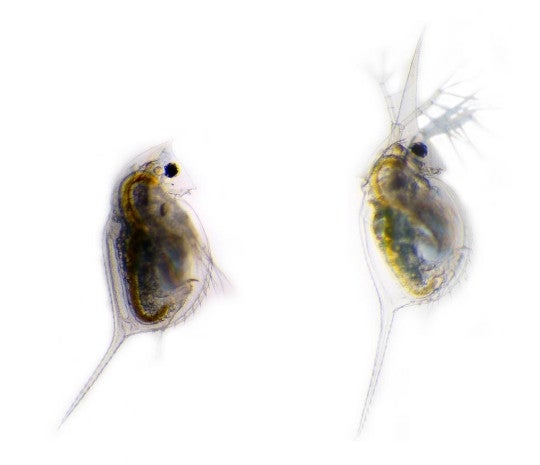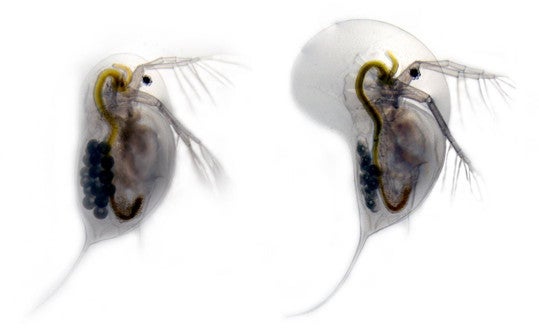This article was published in Scientific American’s former blog network and reflects the views of the author, not necessarily those of Scientific American

Undefended Daphnia lumholtzi (left) and defended (right). The apparatus on the right is Daphnia's way of saying "Really, I'm quite stringy and unappetizing" to the three-spined stickleback fish, Gasterosteus aculeatus. Credit: Dr. Linda Weiss
Cuteness, though unquestionably an awesome force of nature, is no defense against predators. So the water flea Daphnia takes matters into its own hands by growing its own helmets and spikes in the presence of chemical cues that a predator is near. Above, you can see an unarmed Daphnialumholtzi at left, and a punk rocker Daphnia at right.
Daphnia are tiny crustaceans that live primarily in freshwater. Their common name, water flea, comes from their jerky swimming movements and flea-like shape. They feed on algae, protists, bacteria, and miscellaneous other tasty bits. However, they, in turn, are prey for a variety of aquatic organisms, including fish, phantom midge larvae, and backswimmers.
On supporting science journalism
If you're enjoying this article, consider supporting our award-winning journalism by subscribing. By purchasing a subscription you are helping to ensure the future of impactful stories about the discoveries and ideas shaping our world today.
Daphnia defenses work by making it harder for these predators to eat them. Though the authors describe this as an anti-lock key type mechanism, you can think of it as The Porcupine Strategy. Or the Blowfish Strategy. Water flea predators specialize in eating tiny prey, so grower larger or pointier makes eating physically more difficult.
Here’s Daphnia longicephala with its stylish predator-induced helmet that bears some resemblance to the ‘do of a certain Tracy Turnblad. Notice also that its tail spike is spikier – and also the eggs tucked inside the shell toward the back.

Undefended Daphnia longicephala (left) and defended (right). The model on the right is produced in response to the presence of thebackswimmer Notonecta glauca. Credit: Dr. Linda Weiss
Water fleas use tiny antennas to tune into The Predator Channel. Recent research by Linda Weiss at Ruhr-University Bochum, Germany and her colleagues has pinpointed the specific neurotransmitters – dopamine, in particular, seems involved -- that that turn predator cues into juvenile hormonal cascades that trigger Daphnia extra option packages to form. Chemicals made by different predators can thus trigger the growth of structures that best improve the chances of an unfortunate Heimlich Moment.
These results were presented this week at the Society for Experimental Biology Annual Meeting July 4-7 in Brighton, UK .
Additional Reading
Weiss, Linda, Christian Laforsch, and Ralph Tollrian. "The taste of predation and the defences of prey." Chemical Ecology in Aquatic Systems (2012): 111-126.
Hanazato, Takayuki. "Induction of helmet development by a Chaoborus factor in Daphnia ambigua during juvenile stages." Journal of plankton research 12, no. 6 (1990): 1287-1294.